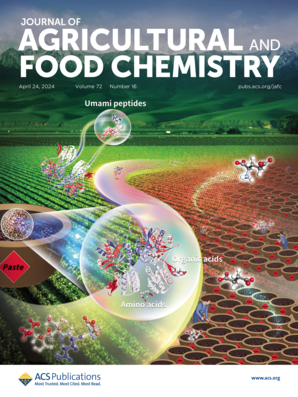CaMKK as a Potential Target for the Natural Product Insecticide Cytisine against Megoura japonica Matsumura.
IF 5.7
1区 农林科学
Q1 AGRICULTURE, MULTIDISCIPLINARY
引用次数: 0
Abstract
Cytisine, a botanical compound, has strong contact activity against a variety of aphids. However, the target and mechanism of its aphidicidal action remain unclear. In this study, the biochemical characteristics of cytisine against Megoura japonica were tested, and the potential target proteins of cytisine were identified, and further verified by fluorescence quenching and molecular docking. Cytisine can affect the activity of Ca2+, Mg2+-ATPase, and Na+, K+-ATPase, with inhibitory rates of 50.00% and 65.22%, respectively. Sixty-eight and fifty-one major binding proteins were identified by drug affinity responsive target stability (DARTS) and cellular thermal shift assay and mass spectrometry (MS-CETSA), respectively. 125 up-regulated and 68 down-regulated genes were obtained by transcriptome sequencing. By combining the candidate target genes of transcriptomics with the potential target proteins of DARTS and MS-CETSA, CaMKK and PPP2R3B were speculated as potential target proteins. The molecular docking results showed that the binding energies of cytisine to CaMKK and PPP2R3B were -6.61 kcal/mol and -6.53 kcal/mol. The fluorescence intensity of CaMKK protein decreased by 28.50, 34.86, 39.68, 51.00, 55.16, 73.99, and 83.29% after different concentrations of cytisine treatment. This research proved that CaMKK is the potential target of cytisine, providing a new target resource for the creation of new pesticides.CaMKK作为天然产物杀虫剂Cytisine对日本松村沼虾的潜在靶点。
胱氨酸是一种植物性化合物,对多种蚜虫具有很强的接触活性。但其杀虫作用的靶点和机制尚不清楚。本研究测试了cytisine对日本野田鼠的生化特性,鉴定了cytisine的潜在靶蛋白,并通过荧光猝灭和分子对接进一步验证。胞氨酸能影响Ca2+、Mg2+- atp酶和Na+、K+- atp酶的活性,抑制率分别为50.00%和65.22%。通过药物亲和力反应靶稳定性(DARTS)和细胞热移质谱法(MS-CETSA)分别鉴定出68个和51个主要结合蛋白。转录组测序得到125个上调基因和68个下调基因。将转录组学候选靶基因与DARTS和MS-CETSA的潜在靶蛋白结合,推测CaMKK和PPP2R3B为潜在靶蛋白。分子对接结果表明,胞氨酸与CaMKK和PPP2R3B的结合能分别为-6.61 kcal/mol和-6.53 kcal/mol。不同浓度的胱氨酸处理后,CaMKK蛋白的荧光强度分别降低了28.50%、34.86、39.68、51.00、55.16、73.99和83.29%。本研究证明了CaMKK是胞氨酸的潜在靶点,为开发新型农药提供了新的靶点资源。
本文章由计算机程序翻译,如有差异,请以英文原文为准。
求助全文
约1分钟内获得全文
求助全文
来源期刊
CiteScore
9.90
自引率
8.20%
发文量
1375
审稿时长
2.3 months
期刊介绍:
The Journal of Agricultural and Food Chemistry publishes high-quality, cutting edge original research representing complete studies and research advances dealing with the chemistry and biochemistry of agriculture and food. The Journal also encourages papers with chemistry and/or biochemistry as a major component combined with biological/sensory/nutritional/toxicological evaluation related to agriculture and/or food.

 求助内容:
求助内容: 应助结果提醒方式:
应助结果提醒方式:


